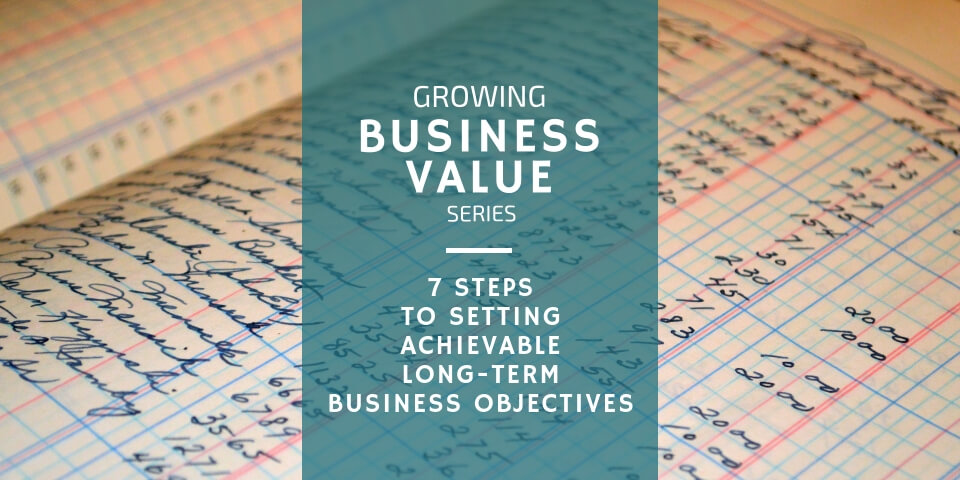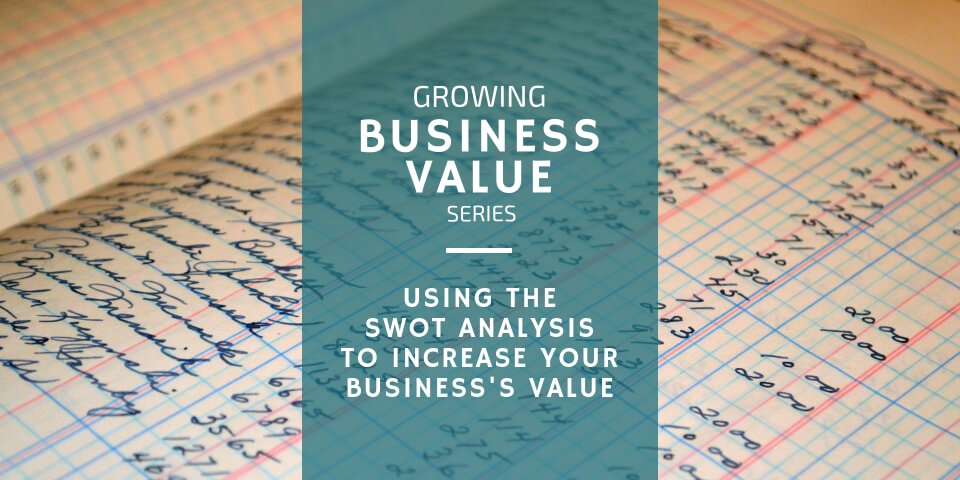
How Your Personal Values Affect Strategic Planning Decisions in Your Business
December 10, 2018
7 Steps to Setting Achievable Long-term Objectives in Business
December 17, 2018Using the SWOT Analysis to Increase the Value of Your Small Business

As a business owner, you’ve probably heard of a SWOT Analysis – a process where you identify your business’ Strengths, Weaknesses, Opportunities, and Threats. However, performing this analysis is nothing more than a time-consuming exercise unless you can put its results to good use. You need to spend time working on those shortfalls to improve your business. Many business owners have used the SWOT assessment to improve their businesses and with the right understanding, so can you. In this article, I will discuss how to use the SWOT analysis within your strategic planning.
Podcast Time Index for “SWOT Analysis in Strategic Planning”
00:45 – Strategic Planning: SWOT Analysis
01:33 – Developing a SWOT Analysis
02:32 – Origins of SWOT
03:25 – Strengths
07:32 – Weaknesses
11:07 – Opportunities
14:42 – Threats
16:46 – SWOT Template
17:41 – Summary
The Elements of a SWOT Analysis
When you’re strategically planning the value growth of your business, you’ll come to the SWOT Analysis. Thus far in the strategic planning framework, you’ve established your Vision and your Mission. Then, you aligned those statements with your personal Values and aligned your team’s values to your business’s culture of values. Now that you’ve identified what your business will look like at its most valuable, it’s time to examine its present state.
The “S”
First, you and your team members need to identify your company’s strengths. Sure, you know your own strengths, but what are the strengths of your business from an internal and external perspective? As an owner, what do you think your business’s strengths are? Do your team members agree? What do your customers believe your strengths are? What are your strengths within your marketplace?
You see, when you’re looking at your company’s strengths, you want to think about them in relation to your competitors. Don’t think of your strengths in a vacuum. Identify the advantage your company has over its immediate competition. In other words, what is your competitive advantage? Maybe it’s size. It could be the volume of sales. Perhaps your employees have unique intellectual capital. Is it your location or your accreditation? Do you have patents or certifications others don’t have?
If you’re having trouble identifying your company’s competitive advantage, write down a list of your organization’s characteristics and values. Then, write down your competitors’ characteristics and values. Compare the two. The items unique to your list will be your strengths – your competitive advantage.
Download our free SWOT Assessment worksheet to use as you read along in this article.
The “W”
When it comes to identifying your company’s weaknesses, you want to face unpleasant truths as soon as possible because your customers and your competition already see them. Now is not the time to be overly optimistic or pessimistic. Work with your team members to identify your business’s weaknesses as realistically as possible.
Like you did with your strengths, find your weaknesses by looking through the eyes of your competition. Are they playing upon your weaknesses? Are they strengthening parts of their organizations to fill in gaps your company is leaving in the marketplace? Do you have certain disadvantages? Maybe you can’t change your “less than perfect” location, but can you do something to let more people know where you are. Are you providing slow customer service because you need more team members or more qualified team members? Are you short on cash flow and resources?
You can’t strengthen your weaknesses or turn your disadvantages into advantages unless you identify them. Therefore, be realistic and honest with yourselves and listen to trustworthy opinions of your team members.
The “O”
After you identify and list your company’s strengths and weaknesses, you’ll look for its opportunities. Go back through your listed strengths. Do any of them provide a chance for your business to grow or to become stronger? What about your weaknesses? Can you turn any into opportunities?
Instead of looking through the eyes of your competition during this planning step, look at your competition. What are their weaknesses? Are they missing the mark in any area? Can you fulfill customer needs that others cannot? Do you see vulnerabilities in other companies? If so, can you fortify and protect yourself against those same vulnerabilities? Can you capitalize on other companies’ misfortunes? In other words, can you learn from their mistakes instead of repeating them yourself? Can you pick up the pieces their companies have left behind?
Maybe government policies are changing. Is your company ready for those changes? What do you need to do to prepare? Are the demographics of your marketplace changing? If your customer base is aging, can you continue to meet their needs, or do you have the opportunity to reach new customers? Perhaps you need to open a second location or relocate your existing company to a structure closer to your customers.
The “T”
Opportunities can be fairly easy to spot. However, threats to your business are harder to identify. You can’t predict what external forces will affect your business or when they will happen. How do you know which PESTs – Political, Economic, Social, or Technological changes or threats – will affect your business next? Change is inevitable. Yet, it’s unpredictable. Therefore, you must identify risk factors that could harm your company’s revenue, profitability, growth, and value. Then, you must do your best to mitigate and manage those risks.
How to Use the SWOT Analysis to Increase the Value of Your Small Business
Now that you’ve examined your business’s Strengths, Weaknesses, Opportunities, and Threats in your strategic planning meetings, what do you do with all of the information you’ve gathered? You don’t want to expend all of this time and energy only to know “more.” Now’s the time to take action. Take your SWOT findings to your team and rank them according to their urgency.
Once you’ve identified which items on each list need your immediate attention, develop a plan of attack. I like to use the 3-9-27 method. This is 3 objectives – 9 tactics – and 27 action steps that work together to accomplish your goals.
Need help with your strategic planning? Download our FREE Strategic Planning Worksheet!
Choose three objectives — I typically make one of them financial in nature — and make a plan to improve those objectives. The objectives will be your long-term goals.
Next, you and your team need to brainstorm 3 tactics for achieving each of your objectives. If your objectives are a 3-year goal (one year per objective), then each tactic should take 3-4 months to complete; each one pushing you closer to your goal.
RELATED ARTICLE: How to Create Long-term Business Objectives
Finally, you should develop 3 measurable action steps to complete each of your 9 tactics. Each action step should be able to be accomplished within a 30-day timeframe. You want these action steps to be measurable so that progress can be assessed and the steps can be adjusted as needed.
Come Together Regularly
Throughout the planning and implementation process, communication and accountability are vital. Because of this, I like to holding regular meetings to discuss progress, encourage, and hold one another accountable. We typically follow a weekly/monthly/quarterly/annually meeting schedule with different objectives for each group of meetings.
The weekly meeting gives us the chance to discuss day-to-day operations while also ensuring that we are on schedule with our action steps.
The monthly meetings allow us to report on the successes and failures of the action steps, as well as how to proceed into the next phase of action and how it’s impacting our tactical approach. If there are any adjustments that need to be made, this is the time to bring them to the table.
Quarterly meetings are for reviewing tactical plans and making sure they are on schedule with achieving your goals. These meetings generally discuss the transition from one tactic to the next, along with rolling out new action steps. It is a good idea to allow each member of your team to report on what has worked and what has been a struggle during the previous quarter. Making their voices heard can be very constructive when it comes to continued morale and adjusting course so that you’re staying on track.
Finally, the annual meeting is where you can look at how far you’ve come in reaching your objectives. If everything has gone well, this can be a bit of a celebratory meeting. However, it’s important to remain focused because there is ALWAYS a “next step.” Just as you will discuss where you were when you began and where you currently are, there will be a time for discussing the next objective. Take what you’ve learned over the previous year and apply it to the next.
When it’s all said and done, you, your team, and your business will be better because of it and by then, it will be time to conduct your next SWOT assessment!
Are you overwhelmed? Contact us. The Financially Simple team of experts is here to help you and your team develop and implement strategic plans based on your SWOT analysis.




